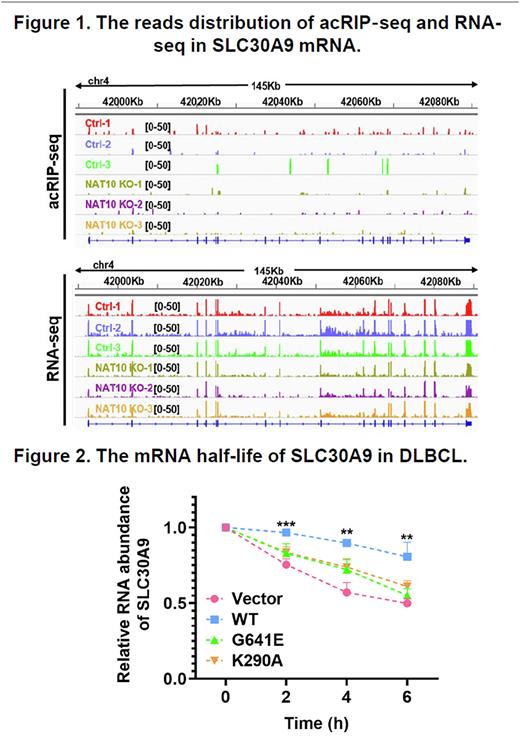Abstract
Introduction: N4-acetylcytidine (ac4C) is a chemical and conserved modification, which plays an essential role in the stability and regulation of mRNA translation. However, the role of RNA ac4C modification in diffuse large B-cell lymphoma (DLBCL) remains unclear. N-acetyltransferase 10 (NAT10), the key enzyme of ac4C modification, participates in various cellular processes. Herein, we explored the functional significance and regulatory mechanism of NAT10-mediated mRNA ac4C modification in the tumorigenesis of DLBCL, which is expected to propose novel therapeutic strategy.
Methods: Lymph node biopsies from 104 newly diagnosed DLBCL patients and 20 reactive lymphoid hyperplasia were collected with informed consents. The biological function of NAT10 was explored through NAT10 knockdown (NAT10 KD) and CRISPR/Cas9 mediated genomic deletion (NAT10 KO). RNA sequencing and acRIP-seq were performed to detect the dysregulated RNA in DLBCL. LC-MS/MS, RIP assay and RNA stability assay were performed to investigate the functional mechanism of NAT10. SCID beige mice were subcutaneously injected into LY1 cells to establish DLBCL xenograft model. Animal experiments were performed in accordance with the principles of the Institutional Animal Care.
Results: We first evaluated the expression level of NAT10 in DLBCL as well as analyzed the correlation between NAT10 expression and clinicopathologic characteristics. Upregulation of NAT10 mRNA were identified in DLBCL. Survival analysis revealed that high NAT10 expression was associated with poor prognosis of DLBCL patients. In addition, high expression levels of NAT10 protein were validated in DLBCL cell lines and newly diagnosed DLBCL patients.
To verify the biological functions of NAT10, we deleted NAT10 expression by CRISPR/Cas9 mediated genomic-editing system. Deletion of NAT10 induced cell cycle attest in G0/G1 phase. Knockdown of NAT10 resulted in similar anti-lymphoma effects. We further investigated the activities of NAT10 inhibition in DLBCL xenograft mice model. The results revealed that deletion of NAT10 significantly suppressed proliferation of DLBCL cells.
RNA sequencing and acRIP-seq of LY1 cells with NAT10 knockout were performed to explore the mechanism of NAT10 in DLBCL. Knockout of NAT10 reduced the enrichment of ac4C peaks and significantly down-regulated the expression of Solute Carrier Family 30 Member 9 (SLC30A9) mRNA levels through integrative analysis of the sequencing results (Figure 1). RIP-qPCR further verified the combination of SLC30A9 and NAT10. Notably, SLC30A9 was downregulated upon NAT10 knockout, and positively correlated with NAT10 expression, suggesting that SLC30A9 may act as a feasible downstream target of NAT10 in DLBCL.
Given that NAT10 is an RNA acetyltransferase, we next explored whether NAT10-mediated expression of SLC30A9 was dependent on ac4C modification. Lower global ac4C level was showed in DLBCL cells with NAT10 knockout. Analysis of SLC30A9 mRNA sequence found that the vast majority of ac4C peaks were distributed in the protein-coding region. Moreover, the NAT10 mut plasmid without a functional RNA helicase domain (K290A) or acetyltransferase domain (G641E) was constructed to explore the regulatory mechanism of NAT10 on SLC30A9 expression. Overexpression of NAT10 wild-type (WT) but not NAT10 mutant induced a significant increase in SLC30A9 expression levels. Furthermore, overexpression of NAT10 WT significantly increased the half-life of SLC30A9 mRNA (Figure 2). The above results suggested that SLC30A9 was regulated by NAT10 in an ac4C-dependent manner.
Conclusions: Taken together, this study provides preclinical evidence for the significance of NAT10 in lymphomagenesis and highlights the regulatory mechanism of NAT10-mediated the expression of SLC30A9 in an ac4C-dependent manner in DLBCL. Further investigations on the specific NAT10 inhibitors in DLBCL will outline a promising treatment approach to target this newly identified oncogene in DLBCL therapy.
Keywords: Diffuse large B-cell lymphoma (DLBCL), N-acetyltransferase 10 (NAT10), Solute Carrier Family 30 Member 9 (SLC30A9), CRISPR/Cas9
Disclosure: No relevant conflicts of interest to declare.
Disclosures
No relevant conflicts of interest to declare.
Author notes
Asterisk with author names denotes non-ASH members.


This feature is available to Subscribers Only
Sign In or Create an Account Close Modal